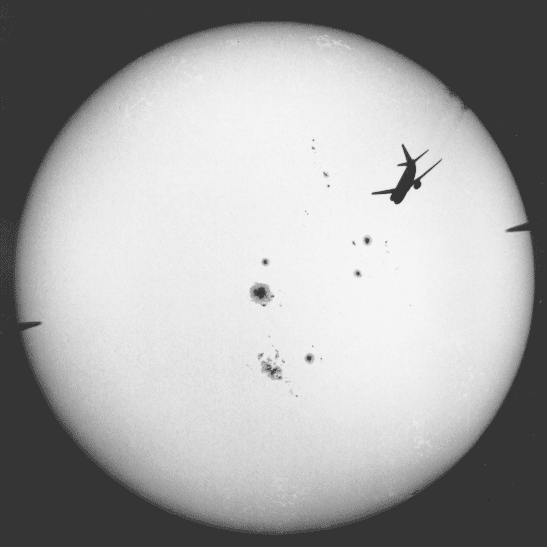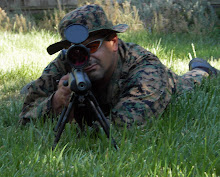I did the best I could and chose the Coronado Solarmax II 90mm scope, it is a very nice telescope overall, good size / weight, great views,etc.
 |
| Sunspot and photosphere as viewed in the Solarmax |
However, if I was to buy it all over again, I might have made some changes.
First I will start with important considerations:
To double-stack or not to double-stack, that is indeed the question:
- I purchased a single etalon (filter) on a 90mm aperture.
- A dual-stack (double etalon) will offer a lot more detail, based upon images I have seen, perhaps up to double the detail as you will get more contrast from the double stack. The contrast comes from the length of wavelength (angstrom) you allow in the scope. For instance my scope has a >.7 angstrom bandpass. Normally a double-stack scope allows in >.5 angstroms, so less light equals higher contrast as less energy is hitting your eye or the camera sensor.
- The double-stacked scopes are about double the cost as well, my suggestion is to trade aperture for double stacking! Spend as much as you can, but if you can get a smaller double-stacked scope, go for that one instead of the larger aperture single etalon scope.
Type of focuser:
This is an important one, that is very hard to get enough information about.
There are two types of focusers that come with solar telescopes:
- Dual-speed crayford types
a) these types of focusers can be used to obtain exact focus, simple and very intuitive to use.
b) they also have smaller focal travel, so you may have to add on extensions to increase the focus capability.
- Helical focusers
a) these types of focusers are much more difficult to use, requiring manipulation of two sliding focus tubes (one for course, one for medium focus) and then a circular focus knob for attaining fine focus.
b) they do have a longer image train, so you don't need to add extensions to the image train.
My suggestion is to find a scope with a dual-speed crayford style focuser, it is much simpler to adjust focus with these types of focusers. When your out in the Sun and covered by a sunscreen to block the sun so you can see your PC screen better, you will thank me for it.
Aperture: How much is enough?
This is a good question that many astronomers face constantly, this is commonly referred to as 'aperture fever' because it seems you never have enough and always want more. :-)
 |
| FOV of Solarmax II 90 |
I find that I like to take my solar scope with me a lot, because as long as it is not cloudy outside, you can pretty much view from anywhere.
The question you need to answer is: are you primarily a visual or photographic user?
- If visual, larger apertures will offer amazing views and lots of detail.
- If photographic, the larger aperture will restrict your Field of View (FOV) to a small portion of the Sun.
Blocking Filter:
This is one that many people don't really consider (myself included). The Coronado offers many different model numbers of blocking filters, here is the difference:
- BF5 - this one is predominantly for visual use, it comes contained in a diagonal with a 1.5 in barrel
- BF10 - this one is ok for visual / ok for photographic, it also comes in a diagonal with a 1.5 in barrel
- BF15 - this one is ok for visual / great for photographic, it also comes in a diagonal with a 1.5 in barrel
- BF30 - this one is tuned for photography but is ok with visual as well. This blocking filter comes inside the telescope, with a 2 in opening. This allows you to either place a 2 in diagonal on the scope or use a camera with a 2 in aperture in prime focus mode.
Recommendations:
1) I would not buy the BF5 or 10 if you plan on doing any photography
2) I would buy the BF15 if I planned on doing 'web cam' photography (this is the one I have on my scope), I have found it difficult to find a way to mount my 2 in aperture camera on this 1.5 in diagonal.
3) This one is interesting in many ways, you have the flexibility of using 1.5 or 2 in aperture cameras and you have a larger blocking filter so more light will enter the camera. However, it appears that the blocking filter is inside the telescope inside the focuser, this may be problematic if you plan on moving from a helical focuser to a crayford style as you will have to find a way to remount the focuser (afaik).
I will likely stay with my BF15 as I look to modify my focuser to a crayford-style (as soon as the warranty expires) :-)
Well, there you have it, overall I am pretty happy with my scope. In the future I will buy a second etalon (double-stack it) to add contrast and detail and change the focuser to a crayford-style to make it simpler to focus.
After all, you cannot be in this hobby without continuing to dump cash into your setup. :-)
I am always happy to answer any questions or share my experiences on the subject.
Clear skies!




